Abstract
User identity and authentication is commonly implemented using username and passwords (U/P). Despite wide adoption of password based authentication, they are considered the weakest link in the chain of secure access. The weak passwords and password reuse are common attack vectors for cyber-crimes. Most organizations enforce strong passwords but it burdens users to follow arbitrary rules for strong passwords and store them securely. Nevertheless, these strong passwords are still vulnerable to account takeover via phishing or social engineering attacks. Managing password also encumbers high cost of maintenance on service providers and help desk.
Simply put, passwords are broken. An alternative to password based authentication is passwordless authentication that verifies user credentials using biometric and asymmetric cryptography instead of passwords. A number of new industry standards are in development such as WebAuthn, FIDO2, NIST AAL, and Client to Authenticator Protocol (CTAP), etc. to implement passwordless authentication. Passwordless authentication can be further strengthened using multi-factor authentication (MFA) using one-time-passwords (OTP) and SMS. Passwordless authentication eliminates credential stuffing and phishing attacks for data breach [1].
The passwordless authentication can work with both centralized/federated systems as well as decentralized systems that may use decentralized identity. The decentralized identity uses decentralized identifiers (DIDs) developed by Decentralized Identity Foundation (DIF) and the W3C Credentials Community Group. This allows users to completely control their identity and data privacy so that users can choose which data can be shared with other applications and services. Following diagram shows progression of authentication from password-based to decentralized identity:

Drawbacks of Password based Authentication
Following are major drawbacks of password based authentication:
Inconsistent Password Rules
There aren’t industry standards for strong passwords and most organizations use internal standards for defining passwords such as length of password, use of special or alpha-numeric characters. In general, longer passwords with a mix of characters provide higher entropy and are more secure [NIST] but it mandates users to follow these arbitrary rules.
Too many passwords
An average user may need to create an account on hundreds of websites that encumber users to manage passwords for all those accounts.
Sharing same password
Due to the large number of accounts, users may share the same password for multiple websites. This poses a high security risk in the event of security breaches as reported by DBIR and it’s recommended not to share the same password with multiple websites.
Changing password
A user may need to change password after a security breach or on a regular basis, which adds unnecessary work for users.
Unsafe storage of passwords by service providers
Many organizations use internal standards for storing passwords such as storing passwords in plaintext, unsalted passwords or using weak hashing algorithms instead of standardized Argon2 algorithms. Such weak security measures lead to credential stuffing where stolen credentials are used to access other private data.
Costs of IT Support
The password-reset and forgot-password requests are one of the major costs of help-desk that consume up-to 50% of IT budget.
Mitigating Password Management
Following are a few remedies that can mitigate password management:
Password managers
As strong passwords or long passphrases are difficult to memorize, users often write them down that can be easily eavesdropped. It’s recommended to use password managers for storing passwords safely but often they come with their own set of security risks such as unsafe storage in memory, on local disk or in cloud [2, 3].
OAuth/OpenID standards
The OAuth/OpenID Connect/SAML standards can be used to implement single-sign-on or social login that allow users to access a website or an application using the same credentials. However, it still poses a security risk if the account credentials are revealed and it weakens data privacy because users can be traced easily when the same account is used to access multiple websites.
Multi-Factor Authentication
The password authentication can use multi-factor authentication (MFA) to hardened security. It’s recommended not to use SMS or voice for MFA due to common attacks via SIM swapping/hacking, phishing, social engineering or loss of device. Instead, one-time passwords (OTPs) provide better alternatives that can be generated using a symmetric key and HOTP/TOTP schemes.
Long-term refresh tokens
Instead of frequent password prompts, some applications use long-term refresh tokens or cookies to extend user sessions. However, it’s recommended to use such a mechanism with other multi-factor authentication or PIN/passcodes.
Passwordless Authentication
Passwordless authentication addresses shortcomings of passwords because you diminish security risks associated with passwords. In addition, they provide better user experience, convenience and user productivity by eliminating friction with password management. Passwordless authentication also reduces IT overhead related with password reset and allows use of biometric on smartphones instead of using hard keys or smart cards.
Passwordless Standards
Following section defines industry standards for implementing passwordless authentication:
Asymmetric password-authenticated key exchange (PAKE)
The Asymmetric password-authenticated key exchange (PAKE) protocols such as Secure Remote Password (SRP) allow authentication without exchanging passwords. However, it’s old and is susceptible to MITM attacks. Other recent standards such as CPace and OPAQUE provide better alternatives. OPAQUE uses an oblivious pseudorandom function (OPRF) where a random output can be generated without knowing the input.
Fast IDentity Online 2 (FIDO2)
FIDO2 is an open standard that uses asymmetric keys and physical devices to authenticate users. FIDO2 specification defines Client to Authenticate Protocol (CTAP) and Web Authentication (WebAuthn) protocols for communication and authentication. WebAuthn can work with roaming physical devices such as YubiKey as well as platform devices that may use built-in biometrics such as TouchID for authentication.
Decentralized Identity and Access Management
Decentralized or self-sovereign identity (SSI) allows users to own and control their identity. This provides passwordless authentication as well as decentralized authorization to control access to private data. The users use a local digital wallet to store credentials and authenticate their identity instead of using external identity providers.
Comparison
Following diagrams compare architecture of centralized, federated and decentralized authentication:
Centralized
In a centralized model, the user directly interacts with the website or application, e.g.
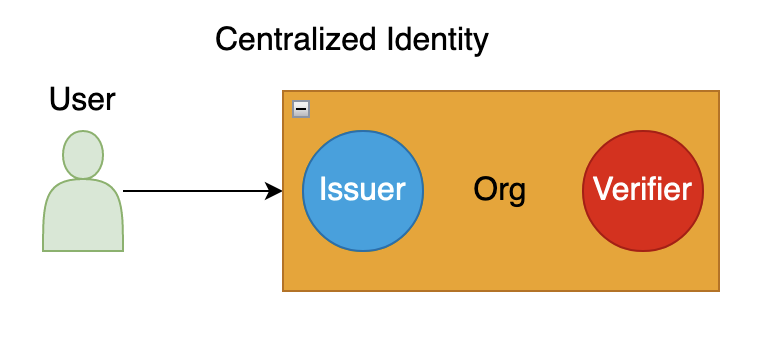
Federated
In a federated model, the user interacts with one or more identity providers using Security Assertion Markup Language (SAML), OAuth, or OpenID Connect (social login), e.g.

Decentralized
In a decentralized model, user establishes peer-to-peer relationships with the authenticating party, e.g.,
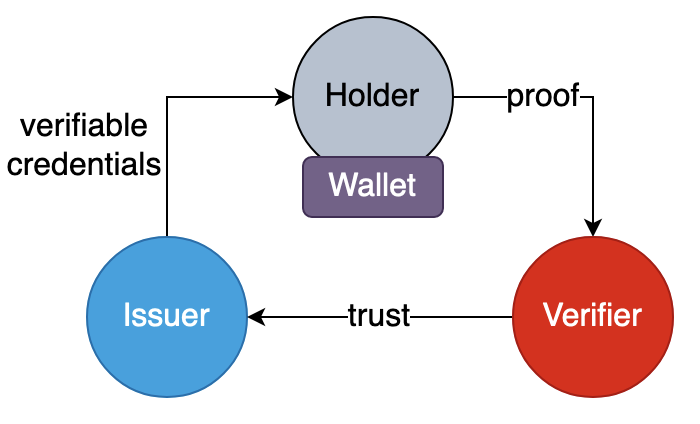
The issuers in decentralized identity can be organizations, universities or government agencies that generate and sign credentials. The holders are subjects of authentication that request verifiable-credentials from issuers and then hold them in digital wallet. The verifiers are independent entities that verifies claims and identity in verifiable-credentials using issuer’s digital signature.
Benefits
Following is a list of major benefits of decentralized or self-sovereign identity:
Reduced costs
User and access management such as account creation, login, logout, password reset, etc. incur major cost for service providers. Decentralized identity shifts the work on the client side where users can use a digital wallet to manage their identity and authentication.
Reduced liability
Storing private user data in the cloud is a liability and organizations often lack proper security and access control to protect it. With decentralized identity, user can control what data can be shared based on use-cases and it eliminates liability associated with centralized storage of private data.
Authorization
Decentralized identity can provide claims for authorization decisions using attribute-based access control or role-based access control. These claims can be cryptographically verified in real-time using zero-knowledge proofs (ZKP) to protect user data and privacy.
Sybil Attack
Decentralized identity facilitates generating new identities easily but they can be protected from Sybil or SPAM attacks where a user may create multiple identifiers to mimic multiple users. The service providers can use ID verification, referral, probationary periods or reputation systems to prevent such attacks.
Loyalty and rewards programs
As decentralized identity empowers users to control the data, they can choose to participate in various loyalty and reward programs by sharing specific data with other service providers.
Data privacy and security
Decentralized identity provides better privacy and security required by regulations such as Health Insurance Portability and Accountability Act (HIPAA), General Data Protection Regulation (GDPR), California Consumer Privacy Act (CCPA), etc. This also prevents identity theft and related cyber-crimes because user data is not stored in a cloud or centralized storage.
Key Building Blocks of Self-Sovereign Identity
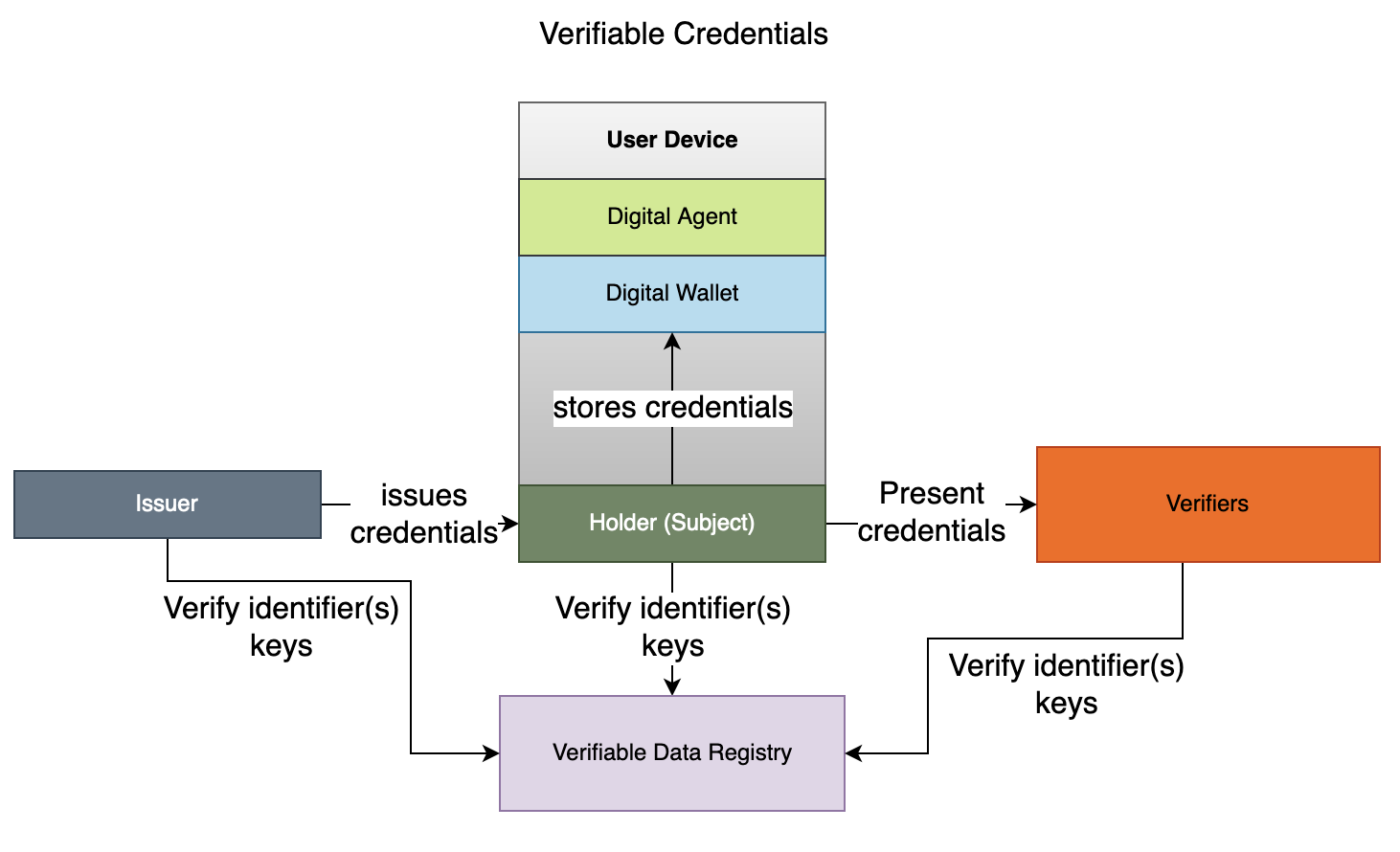
Above diagram shows major building blocks of decentralized or self-sovereign identity as described below:
Verifiable Credentials
The verifiable credentials (VC) stores credentials and claims for a subject that can be verified using public key infrastructure. The VC may be stored using blockcerts, W3C or JSON-ld data models. It may store additional claims or attributes that can support data privacy using zero-knowledge proofs.
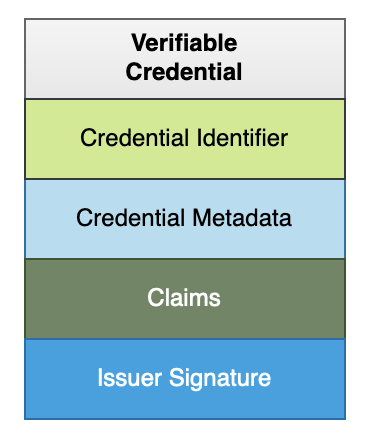
A credential holder may use identity hub to store credentials that can use DIF’s Presentation Exchange spec for serving this data using data-storage standards, e.g.
{
"@context": [
"https://www.w3.org/2018/credentials/v1",
"https://schema.org",
],
"id": "http://plexobject.com/credentials/58473",
"type": ["VerifiableCredential", "Person"],
"credentialSubject": {
"id": "did:plexobject:ebfeb1f712ebc6f1c276e12ec21",
"alumniOf": "PlexObject Solutions"
},
"proof": { ... }
}Decentralized identifiers (DIDs)
W3C Working Group defines decentralized identifier (DID) as a globally unique identifier similar to URL that uses peer-to-peer communication and decentralized public key infrastructure (DPKI).
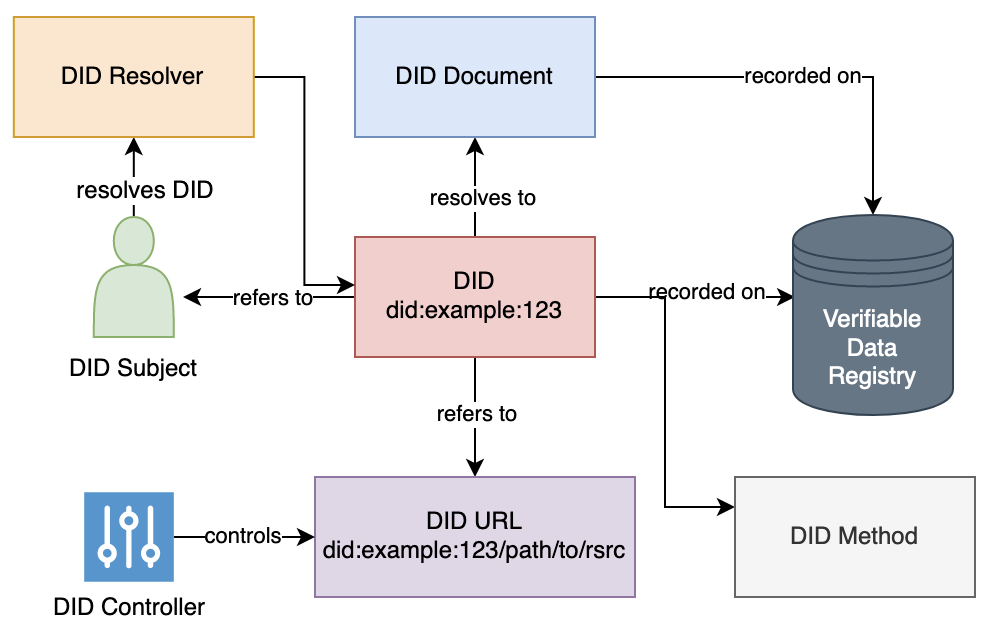
The DID points to the associated document that contains metadata about the DID subject, e.g.
did:plexbject:xyz
and its associated DID document:
{
"@context": "https://www.w3.org/ns/did/v1",
"id": "did:plexobject:xyz",
"authentication": [{
"id": "did:plexobject:xyz#keys-1",
"type": "Ed25519VerificationKey2018",
"controller": "did:plexobject:xyz",
"publicKeyBase58" : "..."
}],
"service": [{
"id":"did:plexobject:xyz#vcs",
"type": "VerifiableCredentialService",
"serviceEndpoint": "https://plexobject.com/vc/"
}]
}In the above example, plexobject is considered a DID method and the DID standards allow customized methods as defined by DID registries.
Public Keys/DID Registries
The public keys/DID registries allow lookup for public keys or decentralized identifiers (DID). A DID registry uses the DID method and protocol to interact with the remote client. Due to support of decentralized identities in blockchain, several implementations of DID registries use blockchains such as uPort, Sovrin, Veres, etc. If a decentralized identifier doesn’t need to be registered, other standards such as Peer DID Method Specification and Key Event Receipt Infrastructure can be used to directly interact with the peer device using DIDComm messaging protocol.
Digital Wallet
The keystore or digital wallet stores private keys, decentralized identifiers (DIDs), verifiable credentials, passwords, etc. The digital wallet uses a digital agent to provide access to internal data or generate new identities. In order to protect wallet data and recovery keys in case of loss of device or data corruption, it can create an encrypted backup in cloud or cold storage. Alternatively, digital wallet may use social recovery by sharding recovery key into multiple fragments using Shamir’s Secret Sharing that are then shared with trusted contacts.
Hardware security module
Hardware security module (HSM) is a physical computing device for storing digital keys and credentials cryptographically. It provides a security enclave for secure execution and preventing unauthorized access to private data.
Multiple Devices
As decentralized applications rely on peer to peer communication, digital wallets can use Decentralized Key Management System (DKMS), Key Event Receipt Infra- structure (KERI) and DIDComm messaging protocols to support multiple devices.
Push Notification
Decentralized identity may use push notifications to verify identity or receive alerts when a user is needed to permit an access.
Summary
The passwords are the bane of online experience and incur high cost of maintenance for service providers. Alternative user authentication mechanisms using passwordless, biometrics and asymmetric key exchange provide better user experience and stronger security. The decentralized identity further improves interoperability and data privacy where users can control who can access their private data and earn rewards for sharing their data. As modern mobile devices already have built-in support for HSM based security enclave, biometrics and push notifications, they provide a simple way to implement digital wallets and decentralized identity. This eliminates security breaches, identity theft and the need for data protection regulations and complex authentication protocols such as SAML/OIDC because data is cryptographically protected on local storage. Though open standards for passwordless authentication and decentralized identity are still in development, they show a bright future to build the next generation of applications that provide better data security, privacy, protection, end-to-end encryption, portability, instant payments and better user experience.